Forming Partnerships to Increase Rural Immunization Rates
August 08, 2023 | Shalini Nair, Heather Tomlinson
Rural communities face many challenges in accessing healthcare, like limited provider availability, gaps in insurance coverage, transportation issues, language barriers, and limited internet access. Additionally, rural populations are more likely to have underlying medical conditions, less likely to have insurance, and live farther from medical facilities.
During the COVID-19 pandemic, overall routine vaccination coverage remained stable; however, there was a notable 4–5% drop in vaccination rates among young children living below the federal poverty level and in rural areas. In response, CDC developed the Let’s Rise initiative and a back-to-school campaign to provide actionable strategies and resources for getting Americans back on schedule with their routine vaccines. This month is National Immunization Awareness Month, highlighting the importance of vaccination for people of all ages. Boosting vaccine access and confidence is crucial to limit the spread of vaccine-preventable diseases.
Barriers to Vaccine Uptake
While they only account for 14% of Americans, rural communities represent nearly two-thirds of primary healthcare shortage areas. Due to the lack of providers, rural Americans often live over 10 miles from their closest healthcare facility and do not always have access to reliable transportation. Additionally, rural communities also have a larger proportion of people who are uninsured and underinsured. Studies have shown that primary care visits and strong provider recommendations can greatly enhance utilization of preventative health measures, such as vaccination, while limited access to these aspects can reduce health outcomes.
The COVID-19 pandemic exacerbated this disparity as many rural hospitals closed and the country faced national workforce shortages. Rural communities were significantly impacted, with 76% of rural adults knowing someone who had COVID-19 and 38% contracting COVID-19 themselves.
Despite this impact, the majority of those polled reported this did not change their intent to get vaccinated. Furthermore, the gap in COVID-19 vaccination coverage between urban and rural areas more than doubled between April 2021 and January 2022, despite rural communities having disproportionately higher COVID-19 disease incidence and mortality. The digital divide also limits access to accurate information on the safety and efficacy of vaccines. States and community groups have taken various actions to address these barriers.
Successful Strategies to Address Low Vaccination Rates in Rural Communities
With support from CDC, ASTHO is working with the National Community Action Partnership and five community action agencies (CAAs) on the Partnering for Vaccine Equity project. A recent blog showcases some of the work the CAAs have implemented to improve vaccine acceptance and uptake and to customize evidence-based strategies to their own communities and neighborhoods.
Two project partners, Pickens County Community Action and Enrichment Services Program, are working to build trust and increase vaccine uptake in rural Alabama by leveraging existing networks and taking a whole-health approach to outreach efforts. In Russell County, Enrichment Services deployed a highly successful paper- and social media-based messaging campaign centered around messages that emphasized three points: Vaccines are Safe, Vaccines Save Lives, and Vaccines Save Money. By reaching out to local churches, Enrichment Services was able to greatly expand the reach of their health promotion messages. In addition, to increase the number of available access points for vaccination, Enrichment Services co-located outreach at schools and engaged local EMT representatives from the National Association of Emergency Medical Technicians for their first-hand knowledge of the community.
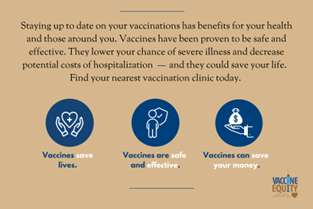
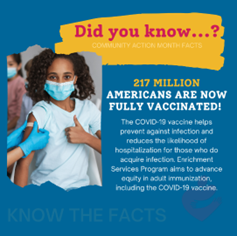
Sample graphics from Enrichment Services' vaccine equity messaging campaign.
In Pickens County, Pickens Community Action relied on existing partnerships with over 30 community organizations to kickstart their vaccine equity efforts. To address access-related barriers, Pickens sponsored rides to and from their vaccine clinics and partnered with local physicians to provide personalized counseling to individuals receiving vaccinations. Notably, they established both a faith-based and a disability services advisory committee to further assist their outreach efforts. Some of their existing partners in the community include the local National Association for the Advancement of Colored People (NAACP), the Black Belt Community Foundation, Whatley Health System, Hill Hospital of Sumter County, The University of Alabama, and elected officials.
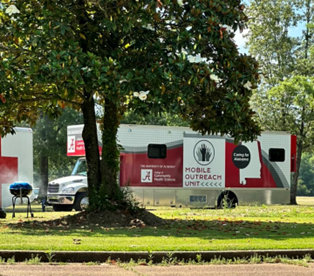
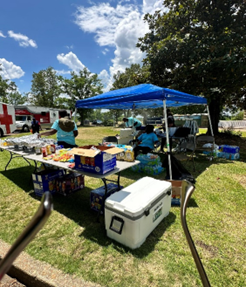
Left: A food table being set up for Pickens’ Community Health Fair at the Tom Bevill Lock and Dam in Pickensville, AL.
Right: A mobile outreach van from partner the University of Alabama rolls in to assist at Pickens’ Community Health Fair.
For both agencies, offering services that address the social determinants of health greatly increased engagement. Both sites found success in offering incentives—such as food or gas gift cards and free food giveaways—but their greatest success has been from co-locating vaccine events with service offerings that address essential needs such as housing, utility assistance, or education. This model has proven highly successful not only for COVID-19 vaccines, but also as a sustainable strategy for general vaccine outreach.
Increasing Vaccination Rates in Farmworker Communities
Numerous successful strategies have been implemented in rural communities largely comprised of immigrants—with a special focus on migrant farmworkers, who labored throughout the pandemic due to the critical nature of their work. In addition to facing barriers related to transportation, health insurance, and language access, many farmworkers are not able to visit a clinic or pharmacy due to their long working hours.
The National Center for Farmworker Health, in collaboration with CDC and over 40 different organizations, worked to diffuse funding, trainings, and tools for building capacity to act during the public health emergency. This network generated over 1.3 million COVID-19 related educational interactions with farmworkers and supported the distribution of over 108,000 COVID-19 vaccine doses during 2020 and 2021. The network also documented effective practices undertaken by community-based organizations and agricultural employers to distribute vaccines, dispel myths, and build vaccine confidence.
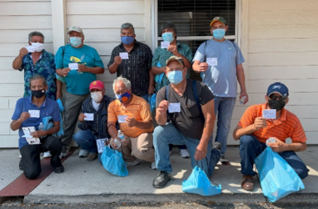
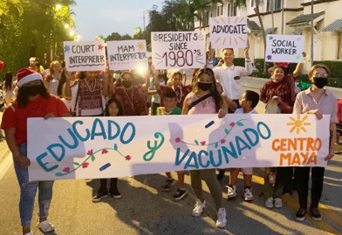
Photos courtesy of the Guatemalan-Maya Center (left) and National Center for Farmworker Health (right).
State Considerations for Implementation
Collaboration with trusted community groups can amplify state efforts to vaccinate communities, particularly in those with low vaccination rates. Working with CAAs and organizations that understand their communities and utilize innovative outreach strategies can help states expand the reach of their messaging. Communications should be tailored to include multilingual messaging and images that resonate with targeted communities.
The National Governors Association developed a guide that provides valuable strategies for states to increase vaccine uptake in their rural communities. To help address the digital divide in their communities, several states have made investments in their digital infrastructure.
Partnering with local pharmacies, federally qualified health centers, and emergency medical services to offer alternative vaccination sites in communities has been integral in improving awareness and access. Holding mobile vaccine clinics with after-hours availability or offering transportation to and from vaccine clinics can help address transportation issues and make vaccines accessible in communities with limited healthcare facilities.
Addressing immunizationinequities in rural communities requires understanding the community and implementing innovative strategies tailored to these populations. Partnering with community-based organizations can help states reach critical audiences and ensure that vaccine efforts are addressing relevant barriers.